Inside The New York Botanical Garden
Esther Jackson
Posted in From the Library on October 3 2019, by Esther Jackson
Esther Jackson is the Public Services Librarian at NYBG’s LuEsther T. Mertz Library where she manages Reference and Circulation services and oversees the Plant Information Office. She spends much of her time assisting researchers, providing instruction related to library resources, and collaborating with NYBG staff on various projects related to Garden initiatives and events.
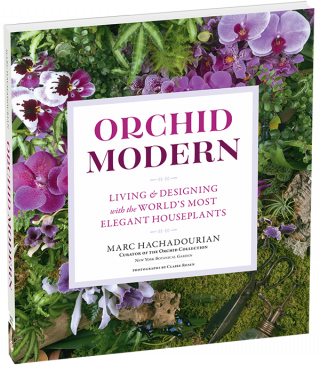 While the NYBG Library’s Plant Information Office answers thousands of questions per year from the public about plant care, sometimes there’s a tricky orchid question about obscure plant identification or growing a less common species or genus. In those cases, we look to Marc Hachadourian, Senior Curator of the NYBG Orchid Collection, for his guidance and his extensive plant knowledge.
While the NYBG Library’s Plant Information Office answers thousands of questions per year from the public about plant care, sometimes there’s a tricky orchid question about obscure plant identification or growing a less common species or genus. In those cases, we look to Marc Hachadourian, Senior Curator of the NYBG Orchid Collection, for his guidance and his extensive plant knowledge.
Now, readers can take advantage of Marc’s expertise by picking up a copy of his recent book—Orchid Modern: Living & Designing with the World’s Most Elegant Houseplants (2019). In addition to his role as Curator, Marc is also the Director of Glasshouse Horticulture at the Garden overseeing the cultivation of tens of thousands of plants for the Garden’s many displays. He has been fascinated with orchids since he was a child, expanding his expertise over the years. He is also an author of Botanica Magnifica: Portraits of the World’s Most Extraordinary Flowers & Plants (2009) and a guest on Martha Stewart, where he answers questions about orchid care and talks about topics from orchid varieties to the NYBG Orchid Show.
Orchid Modern is designed and organized similarly to other books on orchid care. After a general introduction to orchids as a group, there is a general care section; a seasonal chore/care section; approximately 40 pages devoted to decorating projects with orchids (the diagrams here are exceptionally helpful and the projects are beautiful); approximately 80 pages of “easy-care orchids from A to Z;” and a short resources section at the end. The book is appropriate for new orchid enthusiasts who want some general guidance about how to care for their plants, more advanced growers who are looking for information about less common orchid houseplants, and floral arrangers seeking to develop creations with living plants. On the whole, the book is well-designed, well-written, and a great addition to any orchid-lover’s home library.
Posted in From the Library on June 27 2019, by Esther Jackson
Esther Jackson is the Public Services Librarian at NYBG’s LuEsther T. Mertz Library where she manages Reference and Circulation services and oversees the Plant Information Office. She spends much of her time assisting researchers, providing instruction related to library resources, and collaborating with NYBG staff on various projects related to Garden initiatives and events.
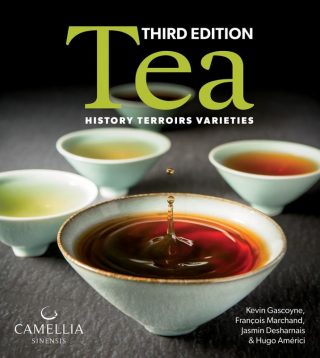 Tea: History, Terroirs, Varieties (ed. 3, 2018) by authors Kevin Gascoyne, François Marchand, Jasmin Desharnais, and Hugo Américi, takes readers into the present-day world of the culture and economy of tea.
Tea: History, Terroirs, Varieties (ed. 3, 2018) by authors Kevin Gascoyne, François Marchand, Jasmin Desharnais, and Hugo Américi, takes readers into the present-day world of the culture and economy of tea.
The authors, co-owners of the Camellia Sinensis Tea House in Montreal, Quebec, give a general look at the topic of tea in four sections: “From Garden to Cup,” which includes information about the cultivation and harvesting of tea; “From One Terroir to Another,” which tours the world’s major tea-growing regions—China, Japan, Taiwan, India, Sri Lanka, Nepal, Vietnam, Kenya, and Malawi; “From Cup to Plate,” which details the preparation of tea; and “Tea and Health,” which includes information about the chemical components of tea, including caffeine levels and antioxidant properties.
There is a brief section related to the history of tea, which is interesting but lacking in citations, and therefore not research-grade. A directory of 42 select teas and 15 recipes using tea, as well as recommendations about infusion accessories and teapots, offer practical guidance to readers who want to explore different aspects of tea consumption. Marketed as a reference work, the book is most useful as a contemporary snapshot of the current landscape of tea distribution, production, and culture around the world.
Readers looking for a more detailed historic treatment of tea may wish to read George van Driem’s impressive (and large) The Tale of Tea: A Comprehensive History of Tea from Prehistoric Times to the Present Day (2019). This work is available for use in the Mertz Library.
Posted in From the Library on June 20 2019, by Esther Jackson
Esther Jackson is the Public Services Librarian at NYBG’s LuEsther T. Mertz Library where she manages Reference and Circulation services and oversees the Plant Information Office. She spends much of her time assisting researchers, providing instruction related to library resources, and collaborating with NYBG staff on various projects related to Garden initiatives and events.
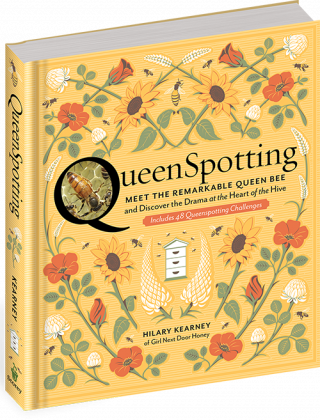 QueenSpotting: Meet the Remarkable Queen Bee and Discover the Drama at the Heart of the Hive (2019) is a new book by Hilary Kearney, creator of Girl Next Door Honey, an educational beekeeping business based in San Diego, California. QueenSpotting is written in a very accessible manner, mostly in first and second person, and is extremely engaging.
QueenSpotting: Meet the Remarkable Queen Bee and Discover the Drama at the Heart of the Hive (2019) is a new book by Hilary Kearney, creator of Girl Next Door Honey, an educational beekeeping business based in San Diego, California. QueenSpotting is written in a very accessible manner, mostly in first and second person, and is extremely engaging.
In the “How to Use This Book” introduction, Kearney notes that readers do not have to be beekeepers to read or enjoy the book. The text is broken into three main sections, each comprised of technical beekeeping information, the author’s personal stories about beekeeping adventures, and “spot the queen” photographs, of which there are 48. Although I am not a beekeeper, I can appreciate that the book’s detailed exploration of one particular aspect of beekeeping—the queen—would be informative and useful for those who do keep bees. That said, my feeling is that the book best works as an educational resource for those who are not already beekeepers, and that more advanced readers might wish to supplement with additional resources for beekeeping tasks. One such task would be “requeening,” referring to when a beekeeper removes an older queen, replacing her with a new queen, preventing the colony from doing so naturally for the purpose of increased honey production.
For readers who would like to learn more about beekeeping, readers who would like to read some entertaining and charming stories about beekeeping adventures, and for those who love visual “eye-spy” games, QueenSpotting is sure to please. Both adults and more advanced younger readers will find Kearney’s enthusiastic and clear manner of writing to be entertaining, infectious, and well worth reading.
Posted in From the Library on June 14 2019, by Esther Jackson
Esther Jackson is the Public Services Librarian at NYBG’s LuEsther T. Mertz Library where she manages Reference and Circulation services and oversees the Plant Information Office. She spends much of her time assisting researchers, providing instruction related to library resources, and collaborating with NYBG staff on various projects related to Garden initiatives and events.
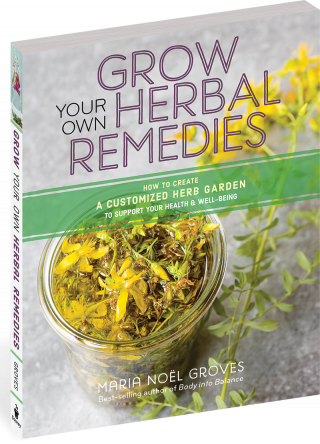 Four titles from Workman Publishing bring herbalism to the home and help readers develop and save botanical recipes and techniques.
Four titles from Workman Publishing bring herbalism to the home and help readers develop and save botanical recipes and techniques.
Grow Your Own Herbal Remedies: How to Create a Customized Herb Garden to Support Your Health & Well-Being (2019) is the second book from Maria Noël Grove, author of Body into Balance. Grove is a Registered Herbalist and a Professional Member of the American Herbalists Guild.
Those who have read my past reviews will not be surprised to hear that I suggest readers do heavy independent research before ingesting any of the plants that Grove features. Thankfully, Grove also encourages readers to take this step. The book is broken into three sections: Skills for Making Medicine, Remedy Gardens, and Healing Garden Herbs. I found the first section to be extremely interesting, as Grove details many ways in which plants can be prepared and preserved for the home. Beyond having an application for herbalism, these methods would be interesting to home cooks and food preservers. The second section details which plants should be used to treat which ailments, according to Grove, and the final section includes herb profiles.
Read More
Posted in From the Library on June 6 2019, by Esther Jackson
Esther Jackson is the Public Services Librarian at NYBG’s LuEsther T. Mertz Library where she manages Reference and Circulation services and oversees the Plant Information Office. She spends much of her time assisting researchers, providing instruction related to library resources, and collaborating with NYBG staff on various projects related to Garden initiatives and events.
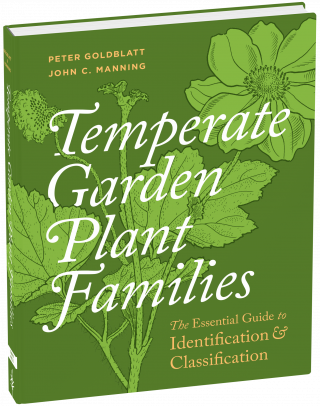 Temperate Garden Plant Families: The Essential Guide to Identification and Classification (2019) sets out to provide gardeners, horticulturists, and plant enthusiasts working with plants of temperate climates information about key families including identification and classification. The book is authored by Peter Goldblatt, an Iridaceae expert recently-retired from the Missouri Botanical Garden, and John C. Manning, a senior specialist scientist at the South African Biodiversity Institute who also works with Iridaceae. The two have collaborated on no fewer than 15 works.
Temperate Garden Plant Families: The Essential Guide to Identification and Classification (2019) sets out to provide gardeners, horticulturists, and plant enthusiasts working with plants of temperate climates information about key families including identification and classification. The book is authored by Peter Goldblatt, an Iridaceae expert recently-retired from the Missouri Botanical Garden, and John C. Manning, a senior specialist scientist at the South African Biodiversity Institute who also works with Iridaceae. The two have collaborated on no fewer than 15 works.
The book’s introduction covers the basics of family classification, plant nomenclature, and plant morphology for readers. 92 of the familes in Temperate Garden Plant Families are arranged alphabetically, with 35 families described with related families. Not all plant families are included—just those for which there is horticultural interest in temperate regions. In many cases, historic families are recognized because they are morphologically distinctive clades (for example, Agapanthaceae and Alliaceae), a useful approach given the arbitrariness of rank and its hierarchical nature, so that these groups can still be diagnosed, whether called families or subfamilies or tribes.
Read More
Posted in From the Library on May 16 2019, by Esther Jackson
Esther Jackson is the Public Services Librarian at NYBG’s LuEsther T. Mertz Library where she manages Reference and Circulation services and oversees the Plant Information Office. She spends much of her time assisting researchers, providing instruction related to library resources, and collaborating with NYBG staff on various projects related to Garden initiatives and events.
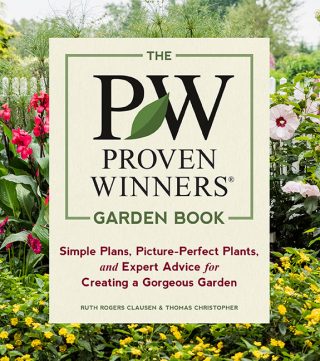 The Proven Winners Garden Book: Simple Plans, Picture-Perfect Plants, and Expert Advice for Creating a Gorgeous Garden (2019) is a new resource from Ruth Rogers Clausen and Thomas Christopher meant to encourage new gardeners with basic information about landscape and container gardening. Both Clausen and Christopher are experienced garden writers, and the resulting text is simple and clear. Proven Winners plants are recommended for a variety of settings and designs. At 192 pages with 309 color photographs and 50 drawings, it is very beginner-friendly.
The Proven Winners Garden Book: Simple Plans, Picture-Perfect Plants, and Expert Advice for Creating a Gorgeous Garden (2019) is a new resource from Ruth Rogers Clausen and Thomas Christopher meant to encourage new gardeners with basic information about landscape and container gardening. Both Clausen and Christopher are experienced garden writers, and the resulting text is simple and clear. Proven Winners plants are recommended for a variety of settings and designs. At 192 pages with 309 color photographs and 50 drawings, it is very beginner-friendly.
Shrubs: Discover the Perfect Plant for Every Place in Your Garden (2018) by Andy McIndoe teaches readers about shrubs in the garden, and makes recommendations for appropriate plants in different growing conditions. McIndoe is managing director of Hillier Nurseries and Garden Centres in Hampshire, England, although Shrubs is written for North American audiences. The book includes information about choosing the right shrub, planting, and care, shrubs for challenging growing conditions, shrubs for restricted planting spaces, and shrubs with desirable characteristics. The format is useful. The plant recommendations can be suspect. For example, McIndoe recommends no fewer than five varieties of non-native Berberis. In four out of five instances, he notes that the genus is invasive in parts of North America. The plant profiles themselves lack what are arguably essential details. Full size and zones are noted, but not nativity, which makes the book far less useful for readers who are hoping to work with native plants. All in all, Shrubs covers a lot of ground. However, it is not useful as a single resource for those interested in the topic, especially for those who wish to garden with native plants.
Posted in From the Library on May 2 2019, by Esther Jackson
Esther Jackson is the Public Services Librarian at NYBG’s LuEsther T. Mertz Library where she manages Reference and Circulation services and oversees the Plant Information Office. She spends much of her time assisting researchers, providing instruction related to library resources, and collaborating with NYBG staff on various projects related to Garden initiatives and events.
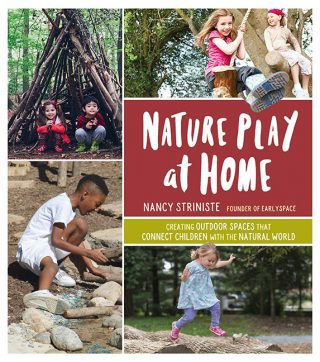 Nature Play at Home: Creating Outdoor Spaces that Connect Children with the Natural World (2019) by Nancy Striniste centers on the development of nature-friendly spaces for children to explore and learn about the outdoors. Striniste has a background as a landscape designer and an early childhood educator, and is the founder and principle designer at EarlySpace. In Nature Play, she synthesizes for readers her over 30 years of experience in creating spaces for children.
Nature Play at Home: Creating Outdoor Spaces that Connect Children with the Natural World (2019) by Nancy Striniste centers on the development of nature-friendly spaces for children to explore and learn about the outdoors. Striniste has a background as a landscape designer and an early childhood educator, and is the founder and principle designer at EarlySpace. In Nature Play, she synthesizes for readers her over 30 years of experience in creating spaces for children.
Nature Play is a delight from the first page. Striniste is an excellent writer who uses clear prose and a strong structure to guide readers in both the creation of nature-friendly spaces for children and in understanding the “why” behind certain features. Enclosures and shelter offer a feeling of safety; pathways can set a pace for how a garden should be experienced, or facilitate navigation of different spaces. The book includes instructions for 12 step-by-step nature play projects, complete with illustrations. It also provides a helpful synthesis of the current state of nature play theory. A detailed and thorough bibliography elevates the work to be a helpful reference resource for teachers and garden educators alike. As a bonus, most of the plants featured are native to North America, with non-native species indicated clearly.
Read More
Posted in From the Library on April 18 2019, by Esther Jackson
Esther Jackson is the Public Services Librarian at NYBG’s LuEsther T. Mertz Library where she manages Reference and Circulation services and oversees the Plant Information Office. She spends much of her time assisting researchers, providing instruction related to library resources, and collaborating with NYBG staff on various projects related to Garden initiatives and events.
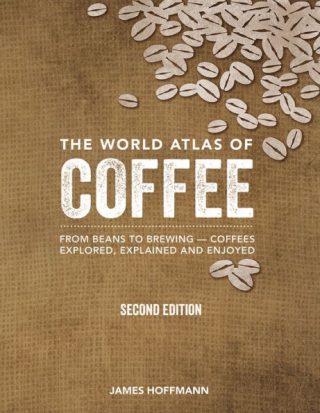 The World Atlas of Coffee: From Beans to Brewing—Coffees Explored, Explained and Enjoyed (2018) is a coffee table book that details the history of coffee, how coffee is prepared, and regions of the world in which coffee is grown. The author, James Hoffmann, is the 2007 World Barista Champion and runs a coffee shop in the UK. The 2018 publication is a second edition with updated statistics and data, with several new countries added to the text, including DRC, Uganda, Thailand, Philippines, China, and Haiti. Although this work presents as a reference book, there are no references cited. Historical images are not included in the photo acknowledgements. While the content is very interesting, without a clear indication as to where the information is coming from, the work is beautiful, but not scientifically valuable. However, in terms of providing entertaining facts and compelling images, this work is quite successful, and may appeal to a culinary historian or amateur chef.
The World Atlas of Coffee: From Beans to Brewing—Coffees Explored, Explained and Enjoyed (2018) is a coffee table book that details the history of coffee, how coffee is prepared, and regions of the world in which coffee is grown. The author, James Hoffmann, is the 2007 World Barista Champion and runs a coffee shop in the UK. The 2018 publication is a second edition with updated statistics and data, with several new countries added to the text, including DRC, Uganda, Thailand, Philippines, China, and Haiti. Although this work presents as a reference book, there are no references cited. Historical images are not included in the photo acknowledgements. While the content is very interesting, without a clear indication as to where the information is coming from, the work is beautiful, but not scientifically valuable. However, in terms of providing entertaining facts and compelling images, this work is quite successful, and may appeal to a culinary historian or amateur chef.
Posted in From the Library on April 11 2019, by Esther Jackson
Esther Jackson is the Public Services Librarian at NYBG’s LuEsther T. Mertz Library where she manages Reference and Circulation services and oversees the Plant Information Office. She spends much of her time assisting researchers, providing instruction related to library resources, and collaborating with NYBG staff on various projects related to Garden initiatives and events.
 Success with Succulents: Choosing, Growing, and Caring for Cactuses and Other Succulents is a 2017 book from John Bagnasco and Bob Reidmuller. Bagnasco has worked in the gardening industry for more than 45 years, first in nurseries and garden centers, and later as a senior magazine editor and radio personality for Garden Compass. Reidmuller has worked for Altman Plants (Vista, CA), the nation’s largest propagator of cacti and succulents, for over 25 years.
Success with Succulents: Choosing, Growing, and Caring for Cactuses and Other Succulents is a 2017 book from John Bagnasco and Bob Reidmuller. Bagnasco has worked in the gardening industry for more than 45 years, first in nurseries and garden centers, and later as a senior magazine editor and radio personality for Garden Compass. Reidmuller has worked for Altman Plants (Vista, CA), the nation’s largest propagator of cacti and succulents, for over 25 years.
Success with Succulents is organized into four sections: What are Cactuses? What are Succulents?, Cactuses and Succulents Outdoors, Cactuses and Succulents Indoors, and Featured Plants. The outdoor gardening guidelines are not region-specific, although most of the species recommended would not be cold hardy in our climate. There are a few outliers—of the plants featured, it is mostly select sedums that are cold tolerant. Arguably the most useful content for our region is in the section pertaining to indoor plants, and the authors cover topics including soil, moisture, pests, and propagation, to name a few. The featured plants section is also very useful, including information about plant family, origin, culture, cold hardiness (by degree in Fahrenheit), propagation method, bloom time, and a blurb about the plant’s appearance and behavior in different landscapes.
All in all, Success with Succulents is a helpful and compact resource for readers who want to care for their existing plants or add a few more plant babies to their collection.
Readers who have questions about how to care for their succulents and troubleshoot problems can contact the NYBG Plant Information Office for help. Guides about caring for succulents and cacti indoors have also been provided.
Posted in From the Library on April 4 2019, by Esther Jackson
Esther Jackson is the Public Services Librarian at NYBG’s LuEsther T. Mertz Library where she manages Reference and Circulation services and oversees the Plant Information Office. She spends much of her time assisting researchers, providing instruction related to library resources, and collaborating with NYBG staff on various projects related to Garden initiatives and events.
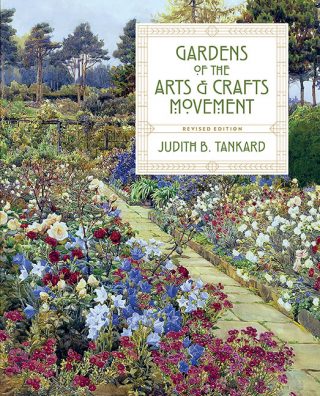 Gardens of the Arts & Crafts Movement is a beautiful book from acclaimed writer Judith B. Tankard. Tankard, who taught at the Landscape Institute of Harvard University for more than 20 years, is the author or coauthor of 10 books on landscape history (Beatrix Farrand: Private Gardens, Public Landscapes, Gertrude Jekyll at Munstead Wood), and recipient of awards from the Garden Writers Association and the American Horticultural Society. Gardens of the Arts & Crafts Movement is a revised edition of Tankard’s 2004 book titled Gardens of the Arts and Crafts Movement: Reality and Imagination.
Gardens of the Arts & Crafts Movement is a beautiful book from acclaimed writer Judith B. Tankard. Tankard, who taught at the Landscape Institute of Harvard University for more than 20 years, is the author or coauthor of 10 books on landscape history (Beatrix Farrand: Private Gardens, Public Landscapes, Gertrude Jekyll at Munstead Wood), and recipient of awards from the Garden Writers Association and the American Horticultural Society. Gardens of the Arts & Crafts Movement is a revised edition of Tankard’s 2004 book titled Gardens of the Arts and Crafts Movement: Reality and Imagination.
Tankard is a careful and thorough researcher, and this book shines as a well-crafted resource for readers who are interested in the Arts and Crafts movement in the United States and Great Britain. Beginning in Britain around the 1880s, before spreading to the United States, the Arts and Crafts movement placed value in traditional craftsmanship as a counter-culture reaction to the trend of industrialization. Simple forms, often from nature, were key design elements, and the movement included social reform interests that were also in keeping with the anti-industrial values of the aesthetic concerns.
Read More
 While the NYBG Library’s Plant Information Office answers thousands of questions per year from the public about plant care, sometimes there’s a tricky orchid question about obscure plant identification or growing a less common species or genus. In those cases, we look to Marc Hachadourian, Senior Curator of the NYBG Orchid Collection, for his guidance and his extensive plant knowledge.
While the NYBG Library’s Plant Information Office answers thousands of questions per year from the public about plant care, sometimes there’s a tricky orchid question about obscure plant identification or growing a less common species or genus. In those cases, we look to Marc Hachadourian, Senior Curator of the NYBG Orchid Collection, for his guidance and his extensive plant knowledge.








